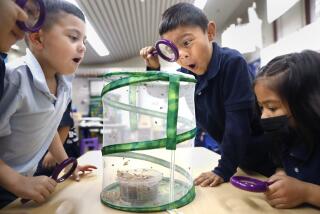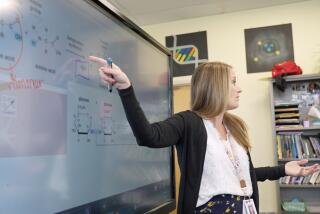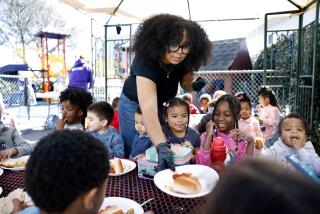Brain Power
- Share via
A plastic cup, animal figurines and a black sock help 2-year-old Sylvia Flores to read. Placing the pieces inside the cup that is covered by the sock, Sylvia’s dad asks her to reach in and fish out the cow trinket. It’s not an easy task, but after several attempts, the curly-haired toddler yanks out the four-legged animal and shouts, “Vaca!”
Although the lessons are in Spanish, they are key in developing Sylvia’s language, vocabulary and word association skills--all of which are fundamental to early learning. It is these types of interactive activities that nourish a young child’s mind, say educators and researchers.
Unlike many other human organs, the brain is not fully developed at birth. Instead, its growth heavily relies on the child’s environment. For that reason, parents are encouraged through early literacy programs--such as the Huntington Beach Ocean View School District’s Even Start--to expose their children to a book-rich and interactive environment.
“You do not come into the world with a fully developed brain,” said Peter Mangione, an expert on early childhood learning. “It’s that genetic blueprint that interacts with the world that creates the architecture of the brain.”
With advanced technology, scientists now can map and study brain activity. Research has shown that the first three years of a child’s life are crucial in “wiring” the brain.
Consider these facts, presented by Mangione at a recent literacy conference:
* Studies have found that the brains of zoo animals were 30% smaller than those of animals that lived in a more natural and richer environment.
* A 17-week-old fetus has 1 billion brain cells that have not been fully connected.
* By the time a child is born, hundreds of thousands of synapses have been made, but millions more are needed.
* There are 100 billion brain cells that need to get connected. And 1,000 trillion synapses eventually form.
* The brain of a 2-year-old consumes twice as much energy as an adult brain.
* More brain activity occurs in the first three years of life than in an adult brain.
* The brain involves not only intellectual development, but also the regulation of emotions and coordination of motions.
“We’re talking about the whole person development when we’re talking about the brain,” Mangione said. “You don’t stop developing at 3 years or at 10 years. It’s a lifelong endeavor.”
Such evidence has helped boost public support in early literacy programs. Examples include Head Start, a federal program for low-income preschoolers, and Even Start, which focuses on family literacy and early childhood development for needy families.
Through the Even Start program, Sylvia Flores’ parents have become loyal readers and play an active role in her learning. Virtually from the moment she was born, they say, they have read to her nightly, spoken to her clearly and often, and filled her ears with language, words and their meanings.
And on a monthly basis, Even Start instructor Julissa Aleman visits the Flores home to provide books and reading lessons. She also quizzes Sylvia’s parents to make sure they are regularly working with her and monitoring her progress.
The district’s Even Start program now serves 30 families, and there’s a waiting list of 65 others. The district is seeking additional funding to help more families, said Donna Stapleton, Even Start coordinator.
“It’s so important to expose children to good reading habits before they get to kindergarten,” Stapleton said. “The kindergarten teachers can pick out the Even Start students. They have expressive language, they know their colors and are more willing to participate in class.”
Sylvia’s dad, Fernando Flores, said he is seeing the fruits of such efforts: Sylvia is picking up words and forming sentences much faster than did her 9-year-old brother, Jesus, who did not go through Even Start.
Already, Sylvia shows a love for books. And even though she cannot read the words, she insists that her father point at the pictures and explain the story.
“It opens her mind and builds her vocabulary,” Fernando Flores said. “It also gives her the interest in books.”
GETTING IN TOUCH and MORE ON READING
* If you have questions for our experts, send them to Reading Page Editor, Los Angeles Times, Times Mirror Square, Los Angeles, 90053 or send e-mail to [email protected]. For stories and activities, see the Kids’ Reading Room in the Southern California Living section every Sunday through Friday.






